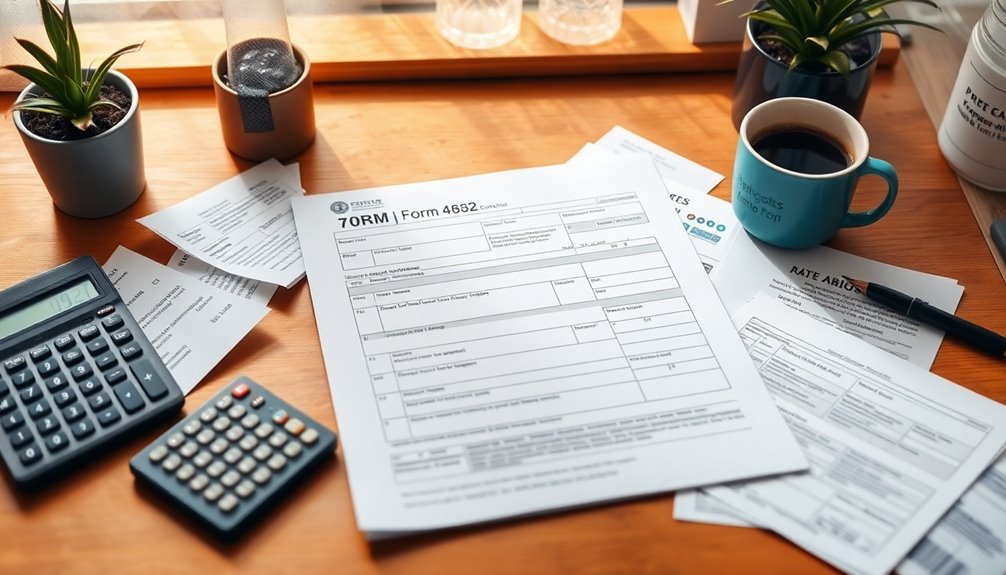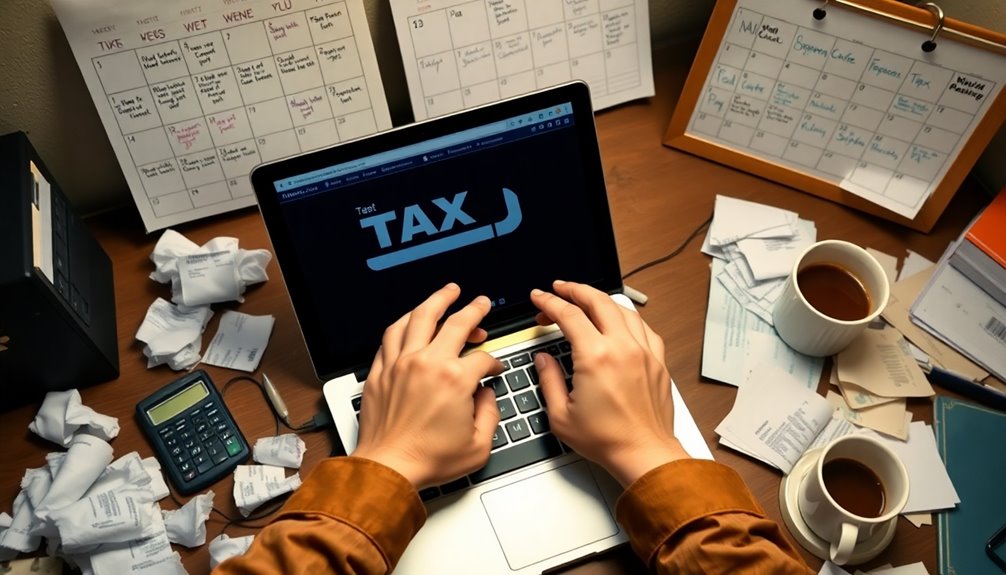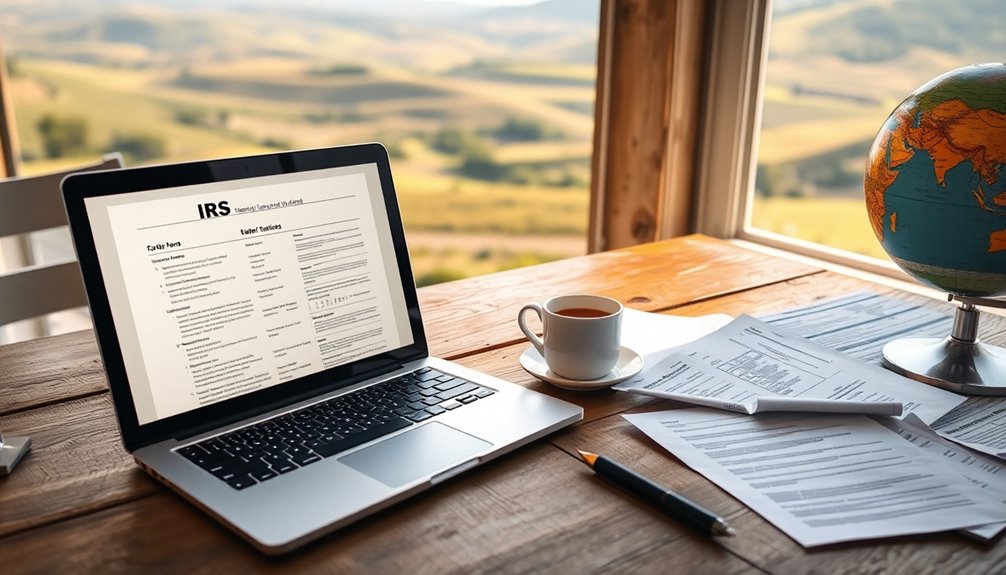Filing taxes without a W-2 or paystub is possible. Start by contacting your employer or payroll department for assistance. If that fails, call the IRS at 1-800-829-1040 for help or request a wage transcript. You can use Form 4852 to estimate your income if you can't get your W-2. Fill it out with accurate personal information and document your efforts to obtain the missing forms. Remember to keep copies of everything for your records. You'll want to manage deadlines carefully to avoid penalties. Stick around to discover more tips for a hassle-free tax process.
Key Takeaways
- Contact your employer for the W-2 form by January 31; if unavailable, reach out to the payroll department or former payroll provider.
- Use Form 4852 to estimate income and withholding, documenting your efforts to obtain the missing W-2.
- Keep detailed records, including your final pay stub, to estimate income accurately for tax filing.
- Consider filing for an extension to avoid penalties if you cannot obtain necessary documents on time.
- Seek assistance from tax professionals or IRS helplines for guidance in complex situations or retrieving missing forms.
Obtaining Necessary Documents

When you're trying to file your taxes without a W-2 or paystub, obtaining the necessary documents becomes crucial. Start by contacting your employer directly to request a W-2 form. Reach out to the payroll department or company leadership; they're required to provide W-2s by January 31. If your employer is no longer in business, don't hesitate to contact their former payroll provider for assistance. Remember, if the W-2 was mailed on the deadline, it might take a few extra days to arrive. If you still can't get the W-2, call the IRS at 1-800-829-1040. When you do, have your personal details and the employer's name and address handy. The IRS may reach out to your employer for you. If you live outside the U.S., use the American Abroad helpline at 1-267-941-1000; they might already have tax information from your employer. As an alternative, you can request a wage transcript from the IRS. This document provides vital income and tax withholding information, helping you estimate your wages and taxes for filing. It's a useful option when a W-2 isn't available. Additionally, it's important to remember that all employees have a right to receive a W-2, ensuring they can accurately report their income.
Using Form 4852

Filing your taxes without a W-2 or paystub can feel daunting, but using Form 4852 simplifies the process. Start by filling out your personal information on Lines 1-3, including your full legal name, current residential address, and Social Security number.
Accuracy here is crucial to avoid any errors, so double-check your details. Don't forget to keep a copy of Form 4852 for your records.
Next, identify the missing form on Line 4. Specify whether it's a W-2 or 1099-R and indicate the tax year you're filing for. Make sure to check the appropriate box to avoid confusion.
In Box 5, you'll need to include your employer's or payer's full name, address, and ZIP code. If you know it, add their tax ID number (TIN) in Box 6. Form 4852 is not a standalone document; it is an integral part of the overall tax filing process.
Finally, document your efforts to obtain the missing form on Line 10. List any contacts you made with the payer or the IRS and include informed estimates of your wages if necessary.
Keep your estimates as accurate as possible to prevent penalties.
Filing Process Overview

Navigating the tax filing process without a W-2 or paystub can be challenging, but breaking it down into manageable steps makes it easier.
First, gather the necessary documents. If you haven't received a W-2 by January 31, contact your employer directly to request a copy. If the employer is out of business, reach out to the payroll service provider. Use your final pay stub to estimate your wages and withholding accurately.
Next, estimate your income and withholding. Input the details from your pay stub into tax preparation software like TurboTax to create a substitute W-2 form. Ensure all information matches to avoid discrepancies, and don't forget to include income from all jobs. In case you cannot obtain a W-2, you can use Form 4852 as a substitute to report your estimated income.
When it comes to filing, choose your method. You can either mail your forms or file electronically. If your situation is complex, consider seeking help from a tax professional.
Remember to manage deadlines; file your return by the deadline to avoid penalties. If a delay arises, proactively request an extension. Keeping detailed records throughout the year will make this process much smoother come tax season.
Impact on Tax Processing

The absence of a W-2 or paystub can significantly impact the timing and accuracy of your tax processing. Without these documents, you might face delays in filing your taxes, which can push back your refund.
You may need to file for an extension to avoid penalties while you wait for the necessary paperwork. To stay proactive, reach out to your employer or payroll provider to obtain the missing documents or consider using Form 4852.
Using Form 4852 requires estimating your wages and tax withholding based on your last pay stub, which may not be fully accurate. This could lead to discrepancies between your estimated values and the actual W-2 data, increasing the risk of an IRS audit. Employers must send W-2 statements by January 31st, ensuring employees have the information needed to file accurately.
If you receive your W-2 after filing with Form 4852, you'll need to amend your return with Form 1040X.
Additionally, filing without a W-2 can delay your refund, as the IRS may take extra time to verify the information.
It's crucial to maintain detailed records of your income and tax withholdings to ensure accuracy and compliance, helping you navigate this complex situation smoothly.
Alternative Income Forms

When you can't provide a W-2 or paystub, exploring alternative income forms becomes important for ensuring your tax filing process remains smooth. These forms can serve as valuable substitutes when traditional documentation isn't available.
Implemented in nineteen states, they help schools assess household income without requiring free or reduced-price meal applications. You might encounter them under various names, like education benefit forms or household information reports. These forms are essential for assessing school poverty levels, which in turn influences funding opportunities for various programs.
These forms aren't just for meal programs; they play a crucial role in determining funding sources and assessing school poverty levels. By collecting this information, schools can access essential resources for technology funding or even provide college application discounts.
To make the process easier for families, districts often rename these forms to clarify their purpose and importance. Including them in the yearly registration process and conducting outreach through school events helps ensure proper collection.
Common Filing Errors

Filing your taxes can be straightforward, but common errors can quickly complicate the process. One major pitfall is providing incorrect basic information. Double-check names and Social Security numbers for you and your dependents, and ensure you've selected the right filing status. Even a simple mismatch with IRS records can lead to delays. Make sure to avoid missing or inaccurate Social Security numbers, as these can invalidate your return.
Mathematical mistakes are another frequent issue. Whether it's an addition error or a misplaced number on your tax forms, these mistakes can cost you. Make sure to report all income accurately and verify any deduction or credit amounts you're claiming.
Additionally, compliance and documentation errors can derail your filing. Don't forget to attach necessary forms like 1099s, and always keep a copy of your signed tax return. Sending your return to the wrong IRS office can also create headaches.
Lastly, don't overlook any eligible deductions and credits. Compare standard versus itemized deductions to maximize your refund, and ensure you're aware of state-specific requirements.
Utilizing tax software can help you navigate these potential pitfalls, making your filing experience smoother and more efficient.
Seeking Professional Help

Navigating the tax filing process can be challenging, especially if you lack standard documents like W-2s or pay stubs. Seeking professional help can simplify your experience significantly.
Tax preparation firms offer one-on-one consultations with experts who can guide you through complex tax situations. They can assist you in obtaining missing W-2 forms from your employers or payroll providers and help estimate your wages using final pay stubs, ensuring you accurately complete Form 4852 if needed.
Additionally, it's important to remember that accurate income reporting is crucial to avoid penalties and audits. Alternatively, you might consider utilizing tax preparation software. These tools walk you through the process, helping you identify deductions, credits, and adjustments. They also provide electronic versions of IRS forms and assist in preparing state and local tax returns.
If you prefer direct assistance from the IRS, their helplines are available to answer your questions. You can also visit local Taxpayer Assistance Centers or use online resources for guidance.
Lastly, if you're an expat, engaging with specialized tax professionals can be invaluable. They understand the unique tax laws that may apply to you and can help navigate those complexities, ensuring you file accurately.
Frequently Asked Questions
Can I File Taxes Without Any Income Documentation?
Yes, you can file taxes without any income documentation.
Even if you lack formal income records, it's often necessary to file, especially if you have other income sources or want to claim tax credits.
You might include a small amount of interest income, like $1, to facilitate the process.
Filing helps establish a record with the IRS, which can benefit you in future years, even if your income is minimal.
What Happens if My Employer Never Sends the W-2?
If your employer never sends the W-2, first reach out to them to check on its status.
Ensure they've your correct address.
If you don't receive it by the end of February, contact the IRS for help. They can guide you and may provide a substitute form.
You can also estimate your wages and file your taxes using Form 4852 if needed, but be prepared for potential processing delays.
Are There Penalties for Filing Taxes Late Without a W-2?
Yes, there are penalties for filing taxes late without a W-2.
If you miss the January 31 deadline, you could face fines starting at $60 per W-2 if filed within 30 days.
Penalties increase significantly if you file later, reaching up to $310 per form after August 1.
Plus, failing to report W-2 income may lead to additional interest and penalties on unpaid taxes, so it's best to act quickly.
Can I Use Bank Statements Instead of a W-2?
You can't use bank statements as a substitute for a W-2 when filing your taxes.
They lack crucial information like wages and taxes withheld, which the IRS requires.
Instead, if you haven't received your W-2, reach out to your employer or use Form 4852 to estimate your income based on your last pay stub.
Make sure to provide accurate details to avoid delays with your tax return processing.
How Do I Correct Errors After Filing With Form 4852?
If you find errors after filing with Form 4852, first compare the corrected information on your new W-2 or 1099-R with what you reported.
If there are discrepancies, you'll need to file an amended return using Form 1040-X. Make sure to complete it with the correct details and attach the corrected form.
Finally, submit it by mail and keep copies of everything for your records. It's crucial to stay accurate to avoid penalties.
Conclusion
Filing your taxes without a W-2 or pay stub can seem daunting, but it's doable. By gathering the necessary documents and using Form 4852, you can accurately report your income. Remember to double-check your information to avoid common errors, and don't hesitate to seek professional help if needed. Staying organized and informed will make the process smoother. So, take a deep breath and tackle your tax filing with confidence!









